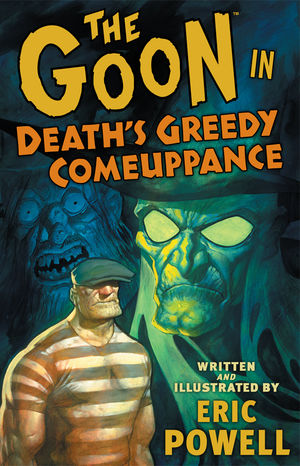 Throughout the course of Eric Powell’s “The Goon,” several characters make a case to have their own series. While the undead priest and Frankie stand out the most in this bunch, The Buzzard has the most depth as far as supporting characters in this series go. His constant pain and suffering aside, he’s got a sullen, sad charisma that lends itself to a kind of character you’d see Clint Eastwood play in a 40-year-old spaghetti Western.
Throughout the course of Eric Powell’s “The Goon,” several characters make a case to have their own series. While the undead priest and Frankie stand out the most in this bunch, The Buzzard has the most depth as far as supporting characters in this series go. His constant pain and suffering aside, he’s got a sullen, sad charisma that lends itself to a kind of character you’d see Clint Eastwood play in a 40-year-old spaghetti Western.
Plus, who wouldn’t want to see more of Powell’s work?
That may just be a wish though, as Powell isn’t capable of pushing a Brian Bendis-like schedule, which forces his hardcore reader-base to patiently wait for his work.
Until now, kinda.
While the first segment of the tenth volume of the graphic novel collection of Goon’s adventures, “Death’s Greedy Comeuppance,” starts where you’d expect it to, with the main character front and center, the end result of it all is an in-depth look at Buzzard and a resulting tale that confirms something dedicated readers of Powell’s work have known for quite some time. Only this time, rather than be fueled by geeks on message boards and podcasts, something tangible and real has confirmed it can work.
This series needs a spin-off. In the worst way.
Although Buzzard is a much different character than the Goon, they have a quiet desperation that binds them together forever. This instantly makes Powell’s style a perfect fit as well. Always the case with his work, he is able to expose a character’s weaknesses, yet allow them to maintain a respectable inner strength. Both of them live to protect, but unlike Goon, who, deep inside knows he deserves some type of happiness but denies himself, Buzzard craves and yearns for only death. Unable to finish himself off due to the undead priest’s curse, he lives in torment and does the only thing he knows how to do right: kill and protect the innocent. This tale makes that need its spine, but puts a soul into the character that makes him instantly relate-able to anyone who’s wanted something in life that they’ll never have.
It helps that the visuals in this trade are a bit darker, with much of the terrain never seen in previous issues. If not proven a long time ago, this shows the reader Powell is able to stretch his upbeat noir comic art style into anything he needs it to be. Mirroring the melancholy script, the palette is darker than any of his previous work. It screams for happiness, for this poor man to be put out of his misery. A shriek that is never answered, a hope that is never granted.
The result of it all is a beautifully sad tale that allows you to see past the gun running, comic mischief and supernatural tones the book usually contains. There’s something more here. The true pleasure comes from finding it.


Leave a Reply